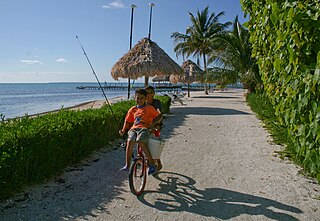| Demographics of Belize | |
|---|---|
 Population pyramid of Belize in 2017 | |
| Population | 397,483 (2022 census) |
| Growth rate | 1.64% (2022 est.) |
| Birth rate | 21.28 births/1,000 population (2022 est.) |
| Death rate | 3.94 deaths/1,000 population (2022 est.) |
| Life expectancy | 75.82 years |
| • male | 74.23 years |
| • female | 77.5 years |
| Fertility rate | 2.62 children born/woman (2022 est.) |
| Infant mortality rate | 11.15 deaths/1,000 live births |
| Net migration rate | -0.96 migrant(s)/1,000 population (2022 est.) |
| Age structure | |
| 0–14 years | 32.57% |
| 65 and over | 4.53% |
| Sex ratio | |
| Total | 1 male(s)/female (2022 est.) |
| At birth | 1.05 male(s)/female |
| Under 15 | 1.04 male(s)/female |
| 65 and over | 0.78 male(s)/female |
| Nationality | |
| Nationality | Belizean |
| Major ethnic | Mestizo (52.9%) |
| Minor ethnic | Creole (25.9%) |
| Language | |
| Official | English |
Demographics of the population of Belize include population density, ethnicity, education level, health of the populace, economic status, religious affiliations and other aspects.
Contents
- Belize's largest cities and towns by population
- Population
- Ethnic groups
- Maya
- Vital statistics
- Structure of the population
- Languages
- Religion
- Life expectancy at birth
- Other demographics statistics
- Population 2
- Ethnic groups 2
- Languages 2
- Age structure
- Median age
- Birth rate
- Death rate
- Total fertility rate
- Net migration rate
- Population growth rate
- Contraceptive prevalence rate
- Dependency ratios
- Religions
- Life expectancy at birth 2
- Urbanization
- Education expenditures
- School life expectancy (primary to tertiary education)
- Unemployment, youth ages 15–24
- See also
- References
- External links
Belize is the most sparsely populated nation in Central America. It is larger than El Salvador. Slightly more than half of the people live in rural areas. About one-fourth live in Belize City, the principal port, commercial centre, and former capital. About 80% of the population are Christian.
Most Belizeans are of multiracial descent. About 52.9% of the population is of mixed Indigenous (mostly Maya) and European descent (or Mestizo), 24.9% are Kriols, about 10.6% are Maya, and about 6.1% are Afro-Amerindian (Garifuna). [1] The remaining population includes European, East Indian, Chinese, Middle Eastern, and North American groups. In the case of Europeans, most are descendants of Spanish and British colonial settlers, whether pure-blooded or mixed with each other. Most Spanish left the nation just after it was taken by the British colonists who, in the same way, left after independence. Dutch and Prussian Mennonites settled in Belize, mostly in isolated areas.
Graphs are unavailable due to technical issues. There is more info on Phabricator and on MediaWiki.org. |
Graphs are unavailable due to technical issues. There is more info on Phabricator and on MediaWiki.org. |
Graphs are unavailable due to technical issues. There is more info on Phabricator and on MediaWiki.org. |











